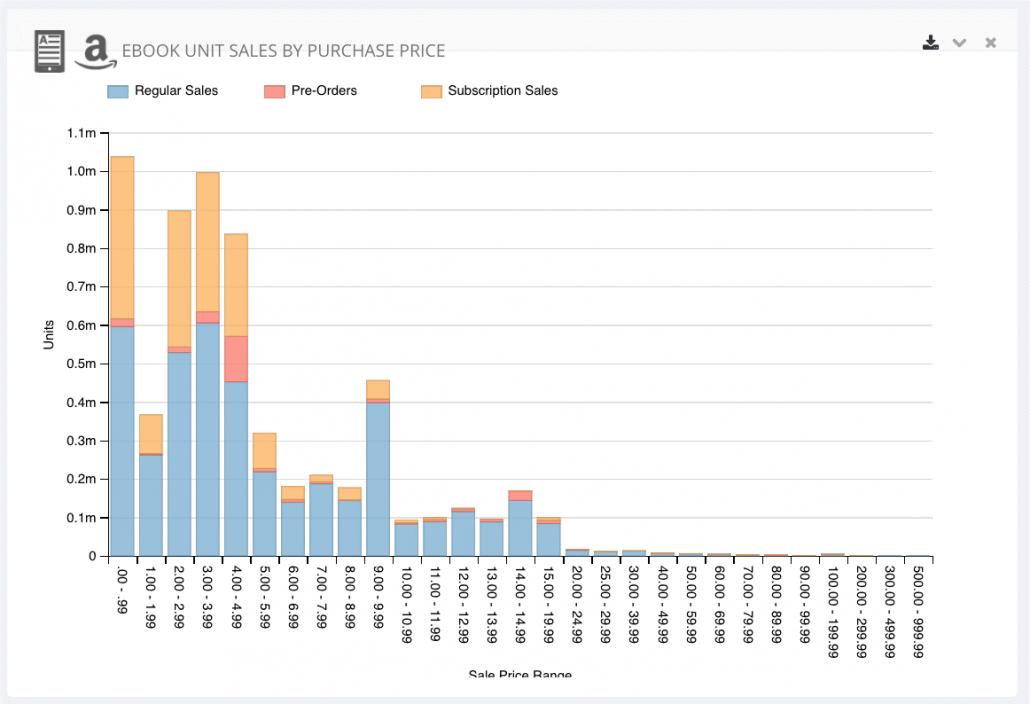Pricing your book to sell is something many authors struggle with. However, having the right price makes it easier for your target readers to find (and buy) your book. With this in mind, it’s important to spend some time researching pricing and getting it right.
What we can learn from book sales reporting
This graph from Author Earnings, is based on the last 3 quarters of book sales from 2017. And, there is quite a bit of interesting information that authors should take into consideration when pricing their book.

First, you can see how well the $.99 price point does performs. However, keep in mind, a lot of these sales are probably either limited time discount promotions, or loss leader titles by prolific series authors. Regardless, it still shows that the era of the $.99 book isn’t over, it’s just being utilized in a more strategic way.
The purchase numbers in the $1.00-$1.99 price point are surprisingly low.
With this I’m inclined to argue it’s partly a sales psychology issue. By this I mean, that it’s sort of outside of the impulse buy range, but it also may be at a price point that actually degrades the book’s perceived value.
So while the price point may result in good book discovery, the sales conversion isn’t there. Realistically, there’s really no point in having one without the other.
Testing and tracking are important processes
Finding the pricing sweet spot for your book is really an exercise in psychology. . As such some trial and error is necessary.
This means you’ll have to stay on top of your sales numbers, and make adjustments as soon as you see sales waning.
The next takeaway is that the $2.00-$2.99 price range seems to do well. From a buyer’s psychology perspective, this makes sense. The price point implies value, without requiring a serious investment. In fact, I often recommend this range to newer authors looking to expand their potential buyer market.
Then there’s the $3.00-$3.99 price point!
These numbers are fantastic, and I love to think it shows how much more value the eBook format is bringing to the table in today’s market.
What’s really exciting here is that lots of bigger name authors willing to put some their backlist titles in this price range. The end result is that mass market books much more affordable, without downgrading perceived value.
Pre-order pricing strategies
According to this graphic, pre-order price points top out between $4.00 and $4.99. However, this is misleading.
I’ve always coached authors to keep their pre-order price lower than their intended retail price. This does a number of things. First, it offers an incentive to purchase early. However, it’s also a fantastic way to push your book through other pre-publication book marketing efforts.
Likely, the pre-order price point has been skewed by traditionally published, big name authors who end up selling their eBooks in the $8.99-$10.99 price range (and sometimes higher) once officially released.
How to find the sweet spot for your book
It’s important to note here that this message is primarily for self-published authors, or authors whose pricing isn’t completely dictated by a publisher.
In fact, this is one of the top reasons I love the indie author movement. It does away with the pricing restrictions included in most traditionally published contracts.
When you’re in charge of your pricing, genre expectations should play a big role in how you price your book.
Take a look at your genre’s bestseller list. Don’t pay attention to household name authors who can demand a higher price. Instead pay attention to the lesser known authors with bestseller titles to see where the sweet spot seems to be.
Be sure to go a few pages deep in the search results. After all, there’s no such thing as knowing too much about your competition.
Ultimately, if you’re still not sure the best price point for your book, I suggest starting with $2.99 for the eBook and $5.99-$9.99 for the print book. This can depend on your genre, or, potentially, your expertise or industry standing if you’re writing non-fiction.
And remember you can play with this some. So no need to get the pricing 100% right the first time. Few of us do, so don’t be afraid to jump in, then commit to tracking and testing a few different price points to see what works.
Don’t go too low
Make sure you leave some room for discount promotions.
If your book is priced too low, you miss out on the immediacy that fuels surges in sales during limited time price reductions, or discount promotions.
These are a great way to get your title in front of hundreds, if not thousands, of readers and potential buyers who let good reviews and a good value help them make their purchasing decisions.
Other important factors
Wouldn’t it be nice if pricing your book perfectly was the only hurdle to sales?
Of course, the reality is quite different, because in order to sell books, you have to be doing a lot of things right. You must have a consistent and smart book marketing plan in place, as well as a solid Amazon presence.
Book discovery is complex (and you can read more about it here).In order for your book to have great discovery, you must have:
- An outstanding, market-appropriate book cover
- A title and subtitle written with the intention of pulling in shoppers
- A description that entices and excites like a movie preview
- Keywords that align with how shoppers are finding books like yours
- Niche categories that increase your chances of hitting bestseller lists
***
Penny Sansevieri, CEO and founder of Author Marketing Experts, Inc. (AME) and Adjunct Professor at NYU, is a best-selling author and internationally recognized book marketing and media relations expert. Her company is one of the leaders in the publishing industry and has developed some of the most cutting-edge book marketing campaigns. To learn more about Penny and AME, visit www.amarketingexpert.com.
